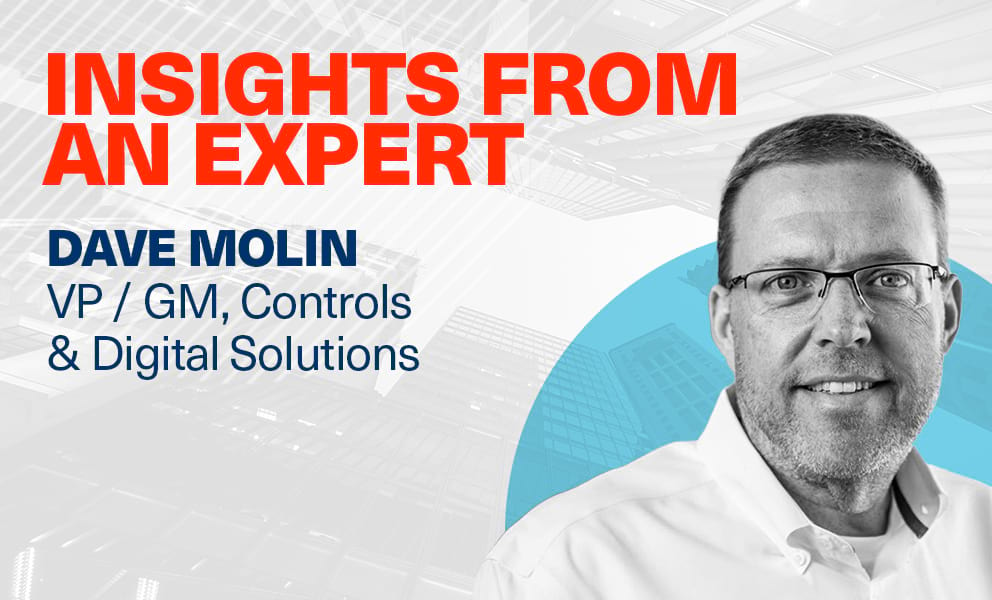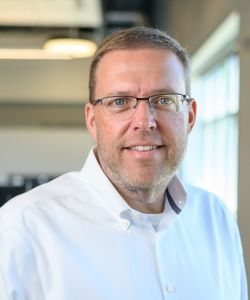
Q. What are some of the most challenging questions or concerns you hear from our customers that they're facing right now about their building operations or energy?
A. It seems like almost every customer has targeted specific environmental, social, and governance (ESG) goals today. While these goals are easy to identify, they can be challenging to achieve. That’s one area where we can help - whether it's reducing energy, improving comfort, delivering against decarbonization or other sustainability goals. Trane systems deliver against those key performance indicators (KPIs) and make our customer's business better at the same time.
Another topic I’ve heard increased interest in is employee value propositions. Most businesses' largest expenses are on their people and they are asking questions such as:
- How do we attract them to our organization?
- How do we make them as productive as possible?
- How do we help them become ambassadors for our business?
In fact, employees’ experience in the workplace is congruent with how they experience the facilities in which they work. I've heard customers talking about how the working environment can actually be a differentiator in attracting and retaining talent.
Indoor environmental quality (IEQ) represents a critical part of this impact. IEQ includes four key attributes: lighting, sound levels, thermal comfort and indoor air quality. They all play an equally important role.
Controls and digital solutions play a major role in delivering a building that addresses the four key attributes of IEQ. With proper IEQ, these attributes equate to proper temperature, noise, light and air quality, all of which provide an environment where employees can perform at their best. These are some of the things that I’ve heard customers talking about these days.
Q. What are some common misconceptions in the market today around improving reliability or resiliency, reducing energy emissions or reducing operational costs?
A. The most common misconception is that you can't have it all. Contemporary HVAC equipment is more reliable, and it is efficient as it's ever been in our industry's history. That equipment also uses refrigerant and technologies that are better for the planet than have ever been used before as well as the latest digital technology to monitor that equipment to help ensure that it continues to run in the most optimized fashion.
Ultimately, this can all reduce customers operational costs while improving comfort and reliability and resiliency. When you do that over decades of use, you can see how this could very positively impact our customers' business performance.
I've heard customers say “We have a newer system but are still struggling to maintain comfort. It didn't minimize energy consumption.” There literally could be dozens of reasons for that, including:
- a subpar design in the first place
- a poorly commissioned turnover of the building or system
- a customer who doesn't understand how to operate those assets, or
- a control system that's been overwritten to a level that's completely out of control
A well-tuned system can deliver improved reliability and resiliency, lower energy consumption in their foreign missions, and decrease operational costs. But it does take effort and intentionality.
For example, are the building operators or users well trained on what to do — and equally important, what not to do? Do they know how to use and optimize the building? Is the system providing the right kind of information to make good business decisions? Does the system provide performance data in the language that an operator understands?
Those are all questions to be considered for any building solution today. And yet, the goal of solving all the problems that this question asks can be solved with current systems today.
Q. What do you think Trane brings to the table that no one else can or does?
A. Trane is the original manufacturer of HVAC equipment, the developer of control systems to operate those assets, and the creator of the digital infrastructure to help ensure optimized performance that has been in operation for over a decade. Combine that with the local resources in sales and service, who are all factory authorized and trained to help customers solve complex problems, and that's what really sets Trane apart from the rest of the market. We have thousands of factory-trained technicians across North America and these technicians can address both control systems and traditional mechanical services
Increasingly, our service offerings are being supported by an expanding digital footprint that also allows for remote inspections that can occur at nearly the same or similar measurements that a technician would routinely do in person.
So, here are some interesting statistics about our digital footprint that differentiate Trane in this in this space. Every 24 hours we capture 8 billion data points from over 30,000 commercial buildings. We manage and route over a million alarms every day from those systems to the right people from this centralized digital infrastructure.
Q. How does building and energy data drive customer outcomes?
A. Trane has been collecting data from buildings for more than a decade, and nobody has a better understanding of how to optimize a very complex set of HVAC assets, controls and third-party devices than Trane. While the underlying technology is really important, it's really the experience and industry knowledge that when put to work, drives the outcomes that customers desire. Sometimes those KPIs include balancing comfort with energy spend. Other times customers are focused on reliability or resiliency, while still other customers are primarily concerned about their environmental or carbon footprint.
Trane can bring resources to address whatever outcomes customers may desire. We can point to many customers in all vertical markets that have leveraged Trane’s technology to drive better results for their facilities and ultimately for their businesses. Buildings are assets and should be treated as such. Technology is a great enabler of improving that asset performance.
Q. If there's one baseline, every customer should understand about their building, what is it and why?
A. It’s a fun question and the answer is pretty simple. My answer is that every building can be better. Every building can perform better. It can have a better energy intensity footprint. Its control system can be tweaked and improved. The building can be providing a healthier environment. The building can have a smaller carbon footprint entirely. All of these goals can be delivered by Trane.
In fact, there have been studies that show even a building that is new, just commissioned 12 months ago may have already deteriorated its energy performance by as much as 10 to 20% from the day it was turned over. In short, there are opportunities in every single building.
Technology is helping shape the impact by keeping buildings operating at a high level. For example, being connected to buildings remotely and the assets contained therein provides Trane witha 24/7 window to see what's happening and make recommendations to keep those buildings operating in the peak fashion that they were designed intentionally to be.
Q. What's the most important thing customers should consider when looking to reduce their carbon footprint?
A. According to the Energy Information Administration, about 60% of electricity today is created by the burning of fossil fuel whether natural gas or coal. By using less energy at the point of consumption, we are by definition, reducing the carbon footprint of the economy. One way to use less energy is by using higher efficiency equipment and controlling it in the most optimized way.
For example, it's easy to decarbonize by just simply turning everything off, but obviously other things ultimately suffer. This is not just about turning things off – it's about using highly efficient equipment with a well-tuned control system in buildings to ultimately help customers meet their decarbonization or sustainability goals.
In addition, you can look at other subsystems in buildings, like lighting technologies that weren’t available even just a few years ago. Integrating lighting and HVAC controls together gives customers the opportunity for even more meaningful energy savings.
Q. What's your philosophy when it comes to helping customers achieve their goals?
A. Trane can impact a significant portion of a customer’s business objectives. The first step lies in a deep understanding of the unique needs of each customer.
For example, a data center client may have an entirely different set of KPIs than a school district might have. Understanding what is important by each vertical and then by each client within a specific vertical, is paramount to crafting solutions that effectively address their unique needs. So, in short, it all starts off with a deep customer understanding.
Once we understand that customer’s goals, we can bring the power and creativity of Trane capabilities to meet them. We provide innovative HVAC equipment. We bring our remarkable, technology-leading controls portfolio. We can integrate with other building subsystems — like lighting, security, video surveillance, irrigation systems and electrical distribution — to bring a single view to that facilities team to manage.
We can connect to all those assets digitally to learn more about how the building is operating and how it’s performing so that we can make recommendations for improvements that makes sense to a facility executive. The last thing to reinforce is that we desire to earn a relationship with those building owners over the life of the building.
Of course, there's an expectation that we deliver those insights and KPIs over the life of that relationship and that's ultimately our expectation with our systems and tools. We want to demonstrate to our customers that we’re making their businesses better.
Q. If there's one service, every customer should be thinking about right now, what is it and why?
A. With the pace of technological change accelerating each year alongside the innovations that are coming from all corners of the world, the universe of potential solutions must be mind-numbing for customers.
People buy from people they trust, from people who care about their outcomes and who are committed to excellence. While the anticipation of new technology might seem really intoxicating from time to time, remember that having local feet on the street, the experts who you can rely on to be there in a moment’s notice, is equally or maybe even more important.

About the author
Dave Molin, Vice President - Controls Commercial HVAC Americas
Dave Molin is the vice president of Controls for Commercial HVAC Americas – which goes to market as Trane® – for Trane Technologies plc. In this role, Dave is responsible for strategy and execution, product management, sales leadership and sales support, and all tools/applications for the controls and controls contracting business. Helping Trane to earn the leadership position in Connected Buildings is his singular driving professional passion.
Prior to his current role, and as part of Ingersoll Rand, he was the vice president of Global Services for the Industrial Technologies business. In this role, Dave led building service offerings for air compressor customers that ensured efficiency, machine health and uptime, and spearheaded the company’s connected equipment strategy.
Joining the company in 1993, Dave has held many general management and corporate leadership positions of increasing responsibility across the organization. His career highlights include leading the team focused on providing consulting engineers with software solutions to design efficient, cost-effective HVAC solutions; creating and leading the federal energy-savings performance contracting business for Trane; and serving in several business development leadership roles. Dave also ran the Building Control Systems business for Honeywell between 2003 and 2013, where he sponsored a number of key channel, product portfolio, and technology acquisitions.
Dave has a bachelor’s degree in mechanical engineering from the University of Minnesota and earned a Master of Business Administration from the University of St. Thomas.











































































